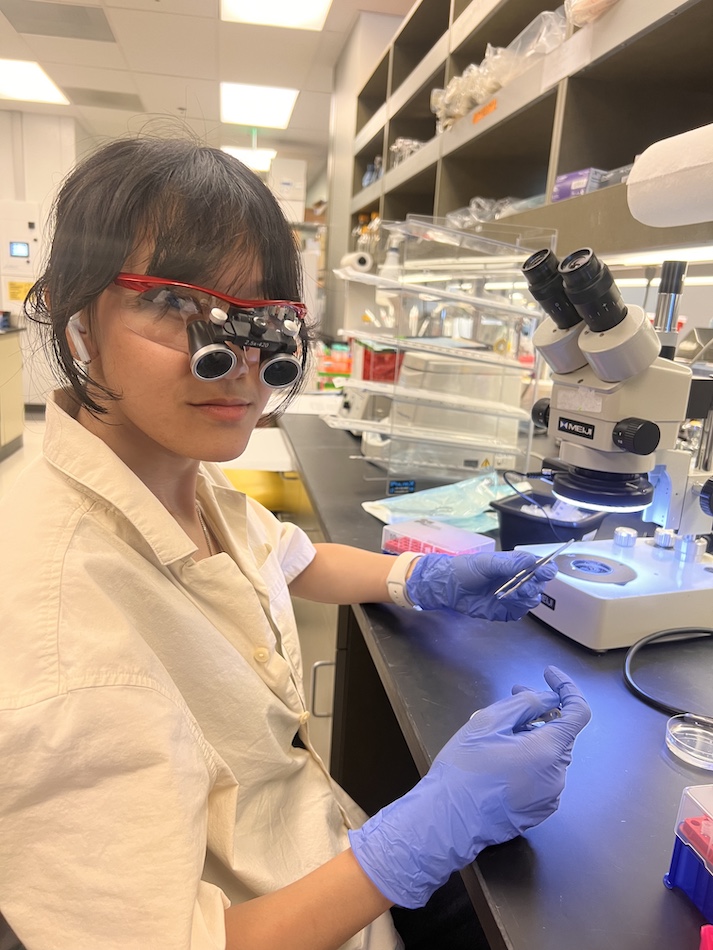Maya Krishnan is a twelfth-grade student at La Jolla Country Day School, a private school just a short walk from La Jolla Institute for Immunology (LJI). For the last two years, Krishnan has been tinkering with a new tool to reduce disease transmission in healthcare settings.
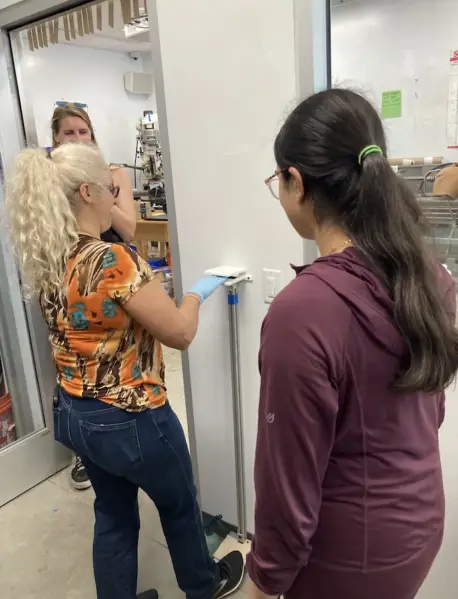
“This project started with the need for safe glove removal,” says Krishnan.
Krishnan’s mom is a physician, so she’s learned first-hand about the risks of contamination in hospitals. “My mom worked with COVID patients every day,” she says. “I also interviewed medical professionals about their needs.”
Krishnan’s invention stands about three feet tall, and it’s mounted to a wall. There’s a foot pedal at the bottom, which operates a clamp that sticks out at waist level. The clamp is meant to help a person remove disposable gloves—like those worn by doctors, nurses, and laboratory workers. Krishnan hopes a hands-free device like this could help users safely remove gloves and avoid spreading contaminants to themselves or others.
Krishnan’s device is bolted next to a doorway inside La Jolla Country Day School’s Innovation Lab, a workshop where students in kindergarten through twelfth grade can experiment with tools, such as a 3D printer, to develop new skills in engineering, programming, art, and much more. Krishnan built her device with guidance from Innovation Lab Manager Robin Robinson and Dan Lenzen, the school’s Director of Design and Innovation.
After two years of trial and error, it’s finally showtime. Krishnan is demonstrating her invention for Biosafety Officer Laurence Cagnon, from the LJI Department of Environmental Health and Safety.
Cagnon’s expertise is vital for keeping LJI scientists safe. She trains and monitors researchers who work with potentially hazardous biological agents and equipment, and she ensures that LJI’s Biosafety Level 3 facility remains a safe place for researchers investigating infectious agents, such as viruses and bacteria.
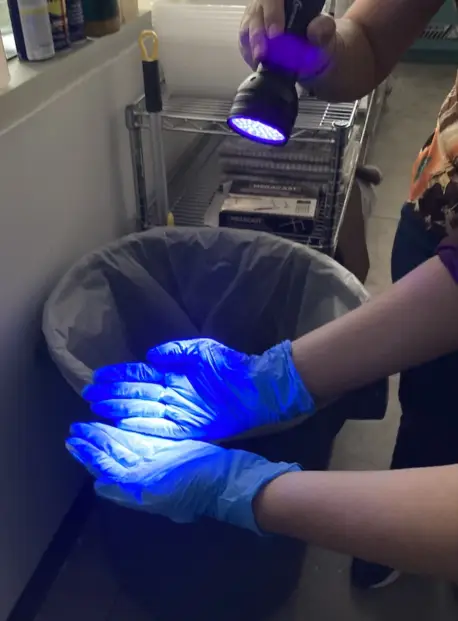
Cagnon also devotes time outside LJI to outreach and education. In an earlier meeting with Krishnan, Cagnon offered advice on which kinds of construction materials are easiest to sanitize.
For Krishnan’s demonstration in the Innovation Lab, Cagnon has brought along a harmless stand-in for bacteria: a kind of fluorescent gel called Glo Germ. Cagnon dons a pair of nitrile gloves and rubs Glo Germ over her hands and fingertips. Krishnan shines a UV flashlight on Cagnon’s gloves. They glow bright. The fake germs are in place.
Krishnan needs to see where the Glo Germ ends up during the demonstration. These visual cues may help her tweak her prototype and improve safety.
The most important part of Krishnan’s device is the clamp, which consists of two small, white platforms sticking out from the wall at waist level. Between the platforms is a small bar. When the white platforms come together, the bar adds an extra “squeeze” to pinch the glove fingertips. The user is then supposed to pull their hand out and leave the glove in the clamp.
Cagnon loosens the fingertips of her gloves. She sticks one hand into the clamp as she steps on the foot pedal.
The device works—it clamps Cagnon’s glove in place as she wiggles her hand free. Cagnon points to the bar inside the device, which is a recent addition to the invention. Cagnon notes how the slight sand-paper texture on the bar gripped the gloves as she took them off. “That texture is an improvement,” Cagnon says.
But there’s work to be done. As Cagnon had suspected, the multi-step process of using the device left her hands and forearms with tiny smudges of Glo Germ. The device wasn’t stopping potential cross-contamination as much as they’d hoped.
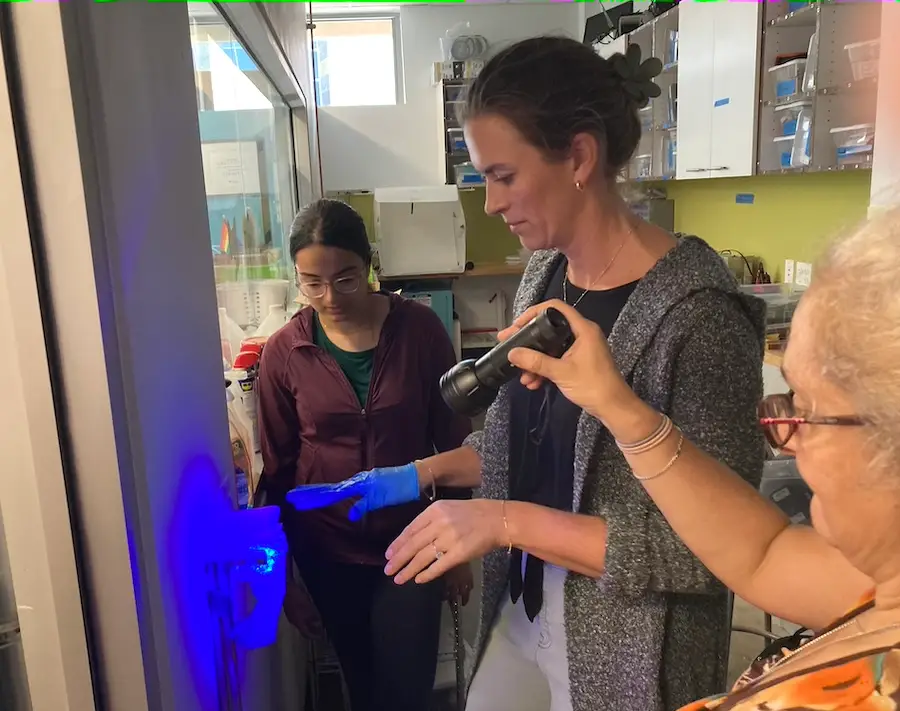
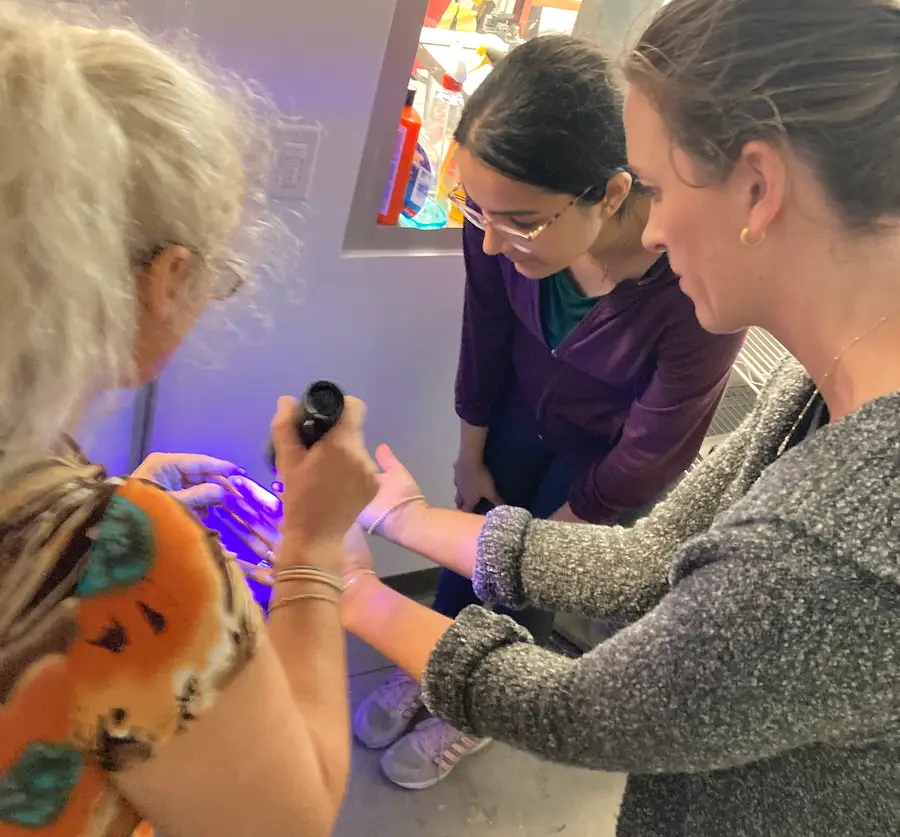
Cagnon says this kind of device is unlikely to meet strict hospital or laboratory safety standards. Biosafety lab workers are already trained in a low-risk technique to remove gloves, she explains. But Krishnan’s concept—if developed further—may help improve food safety in restaurants or reduce cross-contamination in assisted living facilities or veterinary offices.
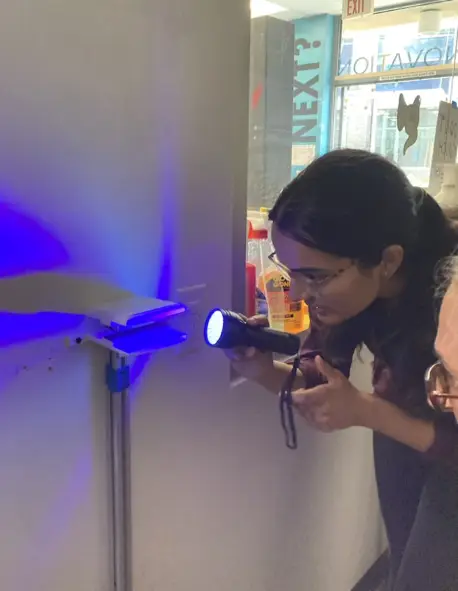
The pair tests how the device handles different glove types. Cagnon also tests the process with a powdered version of Glo Germ, which is helpful for tracking potentially airborne contaminants.
A little bit of Glo Germ spreads each time, but Cagnon says Krishnan shouldn’t be discouraged. Immediately, she and Krishnan start brainstorming solutions. Should the device come with labels to make it more user friendly? Should the bar be bigger? Cagnon suggests making the bar out of rubber, since that would be easier to sanitize after use.
They test the device again and again—until Krishnan has to go on to her next class period. Cagnon gifts Krishnan more gloves, and Krishnan makes plans to tweak her prototype and send Cagnon video clips of how the new version operates.
Cagnon’s mentorship is about more than troubleshooting. She also walks Krishnan through day-to-day life in a lab, describing the surfaces, equipment, and experiments she might encounter. Whether or not her invention succeeds, the project has given Krishnan a new perspective on life as an innovator.

